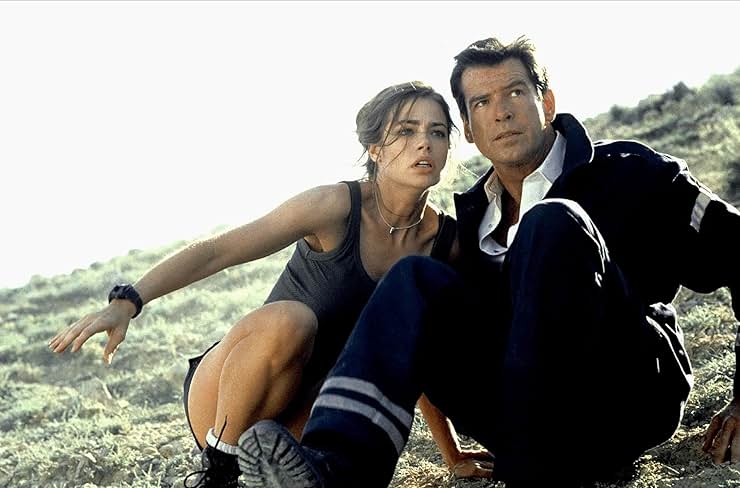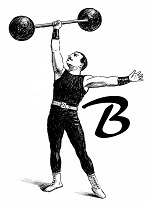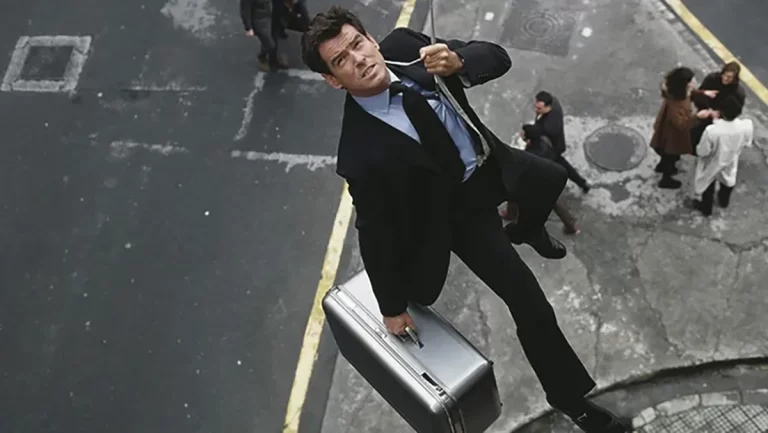The “Bond” franchise has often been hit-or-miss. After a seven-year hiatus, it relaunched itself—and Bond—with 1995’s “GoldenEye,” which was a hit. Casting Pierce Brosnan as the womanizing spy worked for a multitude of reasons, notably his charm and charisma. Brosnan’s Bond was in many ways a modern interpretation of the Connery-era Bond. He looked great in a suit, was fantastic with the one-liners, and fit seamlessly into the spy world. “GoldenEye” not only reformatted the series with a wardrobe and thematic re-design, but also spawned one of the most classic (for the time) first person shooters for Nintendo 64. And while I felt its sequel, “Tomorrow Never Dies” was okay but not transcendent, Director Michael Apted’s 1999 follow-up, “The World is Not Enough,” was infinitely more memorable.
I remember reading a local review of this film when it was first released, its writer smiling at the sheer destruction the film’s opening heralds. The movie starts in Bilbao, Spain, and ends off the seas of Istanbul. It has more than double the budget of “GoldenEye” at $135M, and spends likely half that on the opening act. Before the title card rolls, Bond has retrieved a briefcase of money, escaped death multiple times, repelled down a building using a human as a anchor point, ruined Q’s latest vehicle, engaged in a boat chase, and narrowly escaped an exploding hot air balloon.
For Bond, this Time its Personal
The plot itself is more personal. It’s less Bond (Brosnan) investigating a threat he doesn’t understand, but being drawn into a personal vendetta by a madman against M (reprised by Judi Dench), and becoming a bit bitter by the end. The madman in question is played by Robert Carlyle in a sinister and controlled approach as the terrorist Renard. He was known for kidnapping (and supposedly sexually abusing) an oil tycoon’s daughter, Elektra (Sophie Marceau). After her father (David Calder)—who we learn never paid the ransom for her kidnapping—is killed in the opening, the rest the plot involves finding his killer(s) and his daughter’s possible role in the proceedings.
What works about “The World is Not Enough” is its high-energy action and an fallible Bond, which the series would hook onto in its next installment and the series once Daniel Craig took the reins. I like the details. Bond falls a dastardly height in the film’s opening, and in the next scene his arm is in a sling. Some of the tools he uses by Q Branch are absurd (x-ray glasses and the sexualized way he uses them), but others are more subtle. Bond opens a door with a lock-pick hidden in a credit card in a scene I found intriguing. And Bond’s fallibility and tiredness (Brosnan was 47 here) lend the film more credibility. He gets beat up and outdone. He parks his car in a spot easily found by the film’s villains. And he gets manipulated by a woman he thinks he can trust. Bond is often not in control here and it makes his character more believable.
Thrilling Locations and Action Sequences

The action sequences are thrilling. The film’s opening is the most high-test it gets. However, a shootout down a snowy mountain on skis and parachutes and a caviar plant attack are close second. The film’s settings include France, Turkey, Azerbaijan, London, and Bilbao, all rendered picturesquely and with intrigue. “The World is Not Enough” also features the return of fan-favorite Valentin, reprised by Robbie Coltrane, who would sadly die three years later. Adding to this, the film would be Q actor Desmond Llewelyn’s last portrayal as the quartermaster, himself dying the same year this film was released.
The film’s main villain, Renard, is rendered in that broken way so many bond villains are shown. He doesn’t throw decapitating hats or break metal with his teeth, but he’s dead inside. A MI6 agent tried to kill him at M’s request, and he now has a bullet lodged in his brain. It’s killing him, but cutting off all pain receptors prior to death. A scene where he tortures a henchman by making him hold a scalding rock—Renard feeling nothing—is particularly effective. He’s a mixed bag—like Bond—and his cracks are starting to show. The way that “The World is Not Enough” shows both Renard’s megalomania and insecurity—alongside Bond’s growing nihilism—are apt. And the way Bond seems almost desperate in this film (and sometimes sadistic) hint more at Connery’s and Craig’s portrayals than he’s been given credit for. One scene where he taunts the villain about the death of someone close to him was especially cold. And while the film ends with some hope—and usual womanizing from Bond—it sets the tone for the following installment, which is rather bleak.
A Sold ‘Bond’ Film

The film’s players all do well here. Dench is relegated more to the back burner, but I found some of her scenes reminiscent of the way she relies on Bond in “Skyfall.” Sophie Marceau is good as a seductive heiress with a broken side, similar to the journey Renard’s taken and Bond is currently undergoing. Samantha Bond is good once again as Monneypenny, and I liked Gabor and Goldie as two villainous henchmen. And while written into the script for little other reason than the need to have a Bond girl and the film’s closing joke, I found Denise Richards (playing Dr. Christmas Jones) fun and engaging. She subverts sexist stereotypes set up in the franchise by quite literally being the smartest person in the room. Comedian John Cleese makes an appearance but is more or less wasted.
All-in-all, “The World is Not Enough” is solid. Its action sequences are ahead of its time, and Bond is allowed more depth than he has been hitherto. The jokes fly aplenty and the jet-setting locales make the film interesting as always. Many of the film’s critics and audiences tarnish this film’s enjoyably with lofty expectations. It’s easily the second-best Brosnan film against “GoldenEye,” and a thoroughly fun spy thriller to boot.



